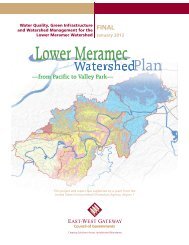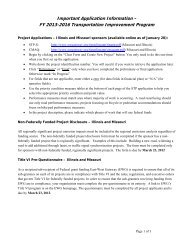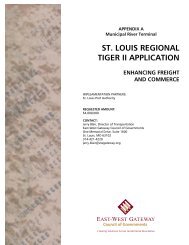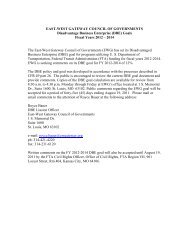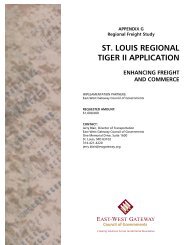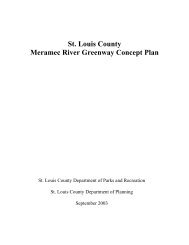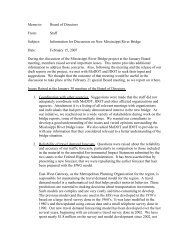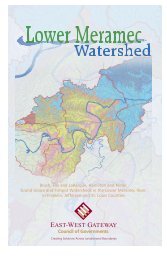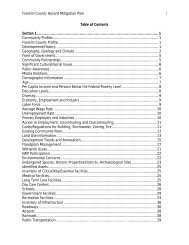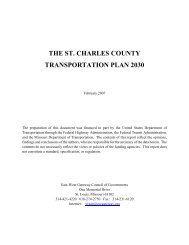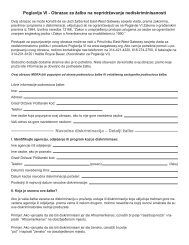Jefferson County - East-West Gateway Coordinating Council
Jefferson County - East-West Gateway Coordinating Council
Jefferson County - East-West Gateway Coordinating Council
You also want an ePaper? Increase the reach of your titles
YUMPU automatically turns print PDFs into web optimized ePapers that Google loves.
58<br />
Likely Locations<br />
<strong>Jefferson</strong> <strong>County</strong> – Section 2<br />
Whenever and wherever conditions are right, tornadoes are possible, but they are most<br />
common in the central plains of North America, east of the Rocky Mountains and west of<br />
the Appalachian Mountains. Refer to Figure J36 for a map of the U.S. that identifies the<br />
wind speeds in various regions; the study area has a high likelihood of severe winds. The<br />
map depicts those areas within the planning region that have experienced tornadoes.<br />
Statistically, <strong>Jefferson</strong> <strong>County</strong> has had 23 tornadoes. St. Charles <strong>County</strong> with 35 tornadoes<br />
has had the most tornado outbreaks, with St. Louis <strong>County</strong> second with 28. St. Louis City<br />
has the least with nine. However, these statistics do not necessarily predict future likely<br />
locations of tornadoes since St. Louis and St. Charles Counties cover larger areas of land.<br />
Type of Damage<br />
FIGURE J36 WIND ZONES<br />
Source: FEMA<br />
The damage from tornadoes comes from the strong winds they contain. It is generally<br />
believed that tornadic wind speeds can be as high as 300 mph in the most violent<br />
tornadoes. Wind speeds that high can cause automobiles to become airborne, rip ordinary<br />
homes to shreds, and turn broken glass and other debris into lethal missiles. The biggest<br />
threat to living creatures (including humans) from tornadoes is from flying debris and from<br />
being tossed about in the wind. It was once thought that the low pressure in a tornado<br />
contributed to the damage by making buildings "explode" but this is no longer believed to<br />
be true. Tornadoes are classified according to the F-Scale developed by Theodore Fujita.<br />
The F-scale ranks tornadoes according to wind speed, and the severity of damage caused<br />
within the wind speed ranges. Table J35 below shows the Fujita Tornado Measurement<br />
Scale.<br />
TABLE J35 FUJITA TORNADO MEASUSREMENT SCALE<br />
Category F0 Gale Tornado (40-70 mph) Light damage. Some damage to chimneys;<br />
break branches off trees; push over shallow<br />
Category F1 Moderate tornado (73-112<br />
mph)<br />
rooted trees; damage to sign boards<br />
Moderate damage. The lower limit is the<br />
beginning of hurricane wind speed; peel<br />
surface off roofs; mobile homes pushed off<br />
foundations or overturned; moving autos



